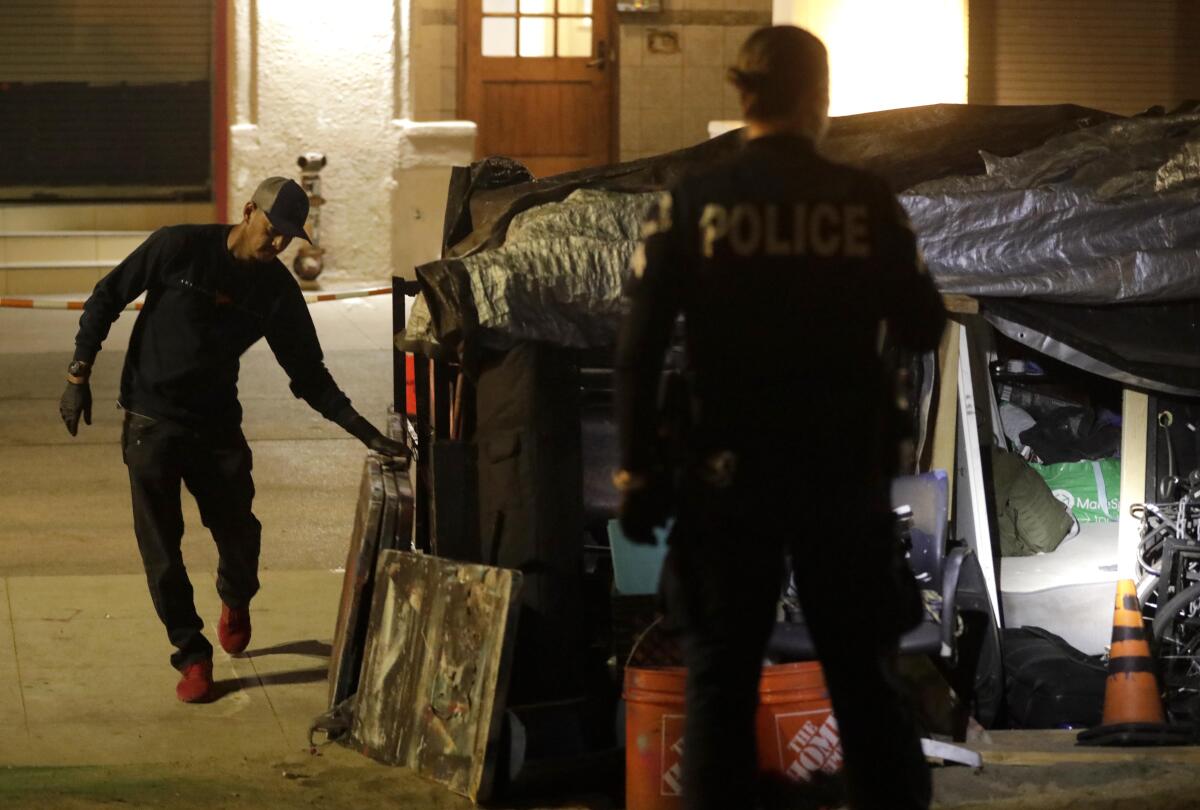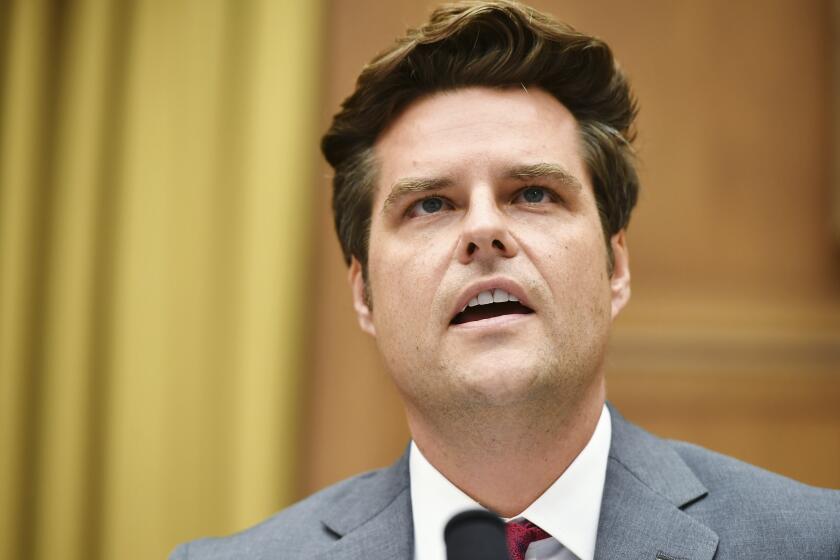Editorial: The recall candidates’ plans on homelessness won’t lessen the problem and could get California sued

California’s gubernatorial recall candidates have seized on the grim state of homelessness as a prime issue upon which to flay Gov. Gavin Newsom and appeal to voters frustrated by the proliferation of encampments. Their basic message: Tents overrun our sidewalks and parks and beaches, filled with mentally ill individuals who need to be forced into treatment or a shelter.
The number of homeless people did, in fact, rise in California from 2019 to 2020, going up 6.8% to 161,000. But homelessness went up in most other states as well, according to the Department of Housing and Urban Development. And no matter how logical it may seem to clear the streets by forcibly relocating homeless individuals, that doesn’t make them disappear. People will simply move to another block. Or if they go to a shelter, the stay will most likely be brief.
The most prominent recall candidates haven’t just criticized Newsom; they’ve laid out plans for addressing the homelessness crisis. Unfortunately, most of those plans call for sweeping, heavy-handed and potentially unconstitutional approaches to a complex problem that requires complex solutions. Here’s a sampling of their ideas, good and bad.
Right to shelter
Enacting a right to shelter, an idea championed by former San Diego Mayor Kevin Faulconer, would force municipalities to supply enough shelter beds to handle every unsheltered homeless person. And yes, there is a need for more shelter in some municipalities, including Los Angeles.
But forcing cities to build enough shelters to accommodate every homeless person would siphon off money that could be better spent on permanent housing for homeless people or rental assistance and rent vouchers. And just pairing a right to shelter with a legal obligation to take it, as Faulconer proposes, would not enable cities to compel homeless people to move into shelters any more than they can compel them into mental health treatment. (See below.)
All a municipality can do is to force people off a sidewalk or out of a park, and that’s what Faulconer’s plan is really about — enforcement. Yet homeless people will find another sidewalk or park unless law enforcement officers spend all their time patrolling for people to shoo away.
Campgrounds
“We have to provide some place for those people to go,” celebrity candidate Caitlyn Jenner told a TV news reporter on Inside California Politics. Referring to the Department of Veterans Affairs campus on L.A.’s Westside, she added: “If you notice at the veterans facility, there’s these big open fields and a lot of places there.”
In fact, shortly after the pandemic began, the VA set up a sanctioned campground for homeless veterans on a grassy field on its 388-acre campus. Veterans live in tents and get services, food, water, restrooms and security on the grounds. That’s a workable form of temporary shelter.
But simply putting homeless people and their tents in a big, open field would serve only to move homeless people out of sight, which doesn’t help return them to sustainable independence. To be effective, sanctioned campgrounds need to offer people restrooms, food and public transportation — and just as important, have case managers who can get them moving toward permanent housing and services.
Treatment before housing
Replacing the prevailing “Housing First” philosophy with “Treatment First” — a position staked out by candidate John Cox — is about as reactionary as you can get. The housing-first approach is based on the idea that people need basics like housing before they can tackle other issues, such as unemployment, mental health problems or substance abuse. And housing first doesn’t mean housing only, but rather housing accompanied by services that chronically homeless people can use to tackle their other problems.
Does this work for every homeless person? No. Some homeless people have such acute mental illness that they do need some kind of residential treatment program. But tens of thousands of homeless people have gone into permanent housing and stayed. L.A. Homeless Services Authority officials say that 90% of people who go into permanent supportive housing in L.A. County are still housed a year later. The National Alliance to End Homelessness puts the retention rate at 98%.
This approach has been accepted as the best practice by service providers, county mental health agencies, the California Legislature and HUD, which had been committed to the practice before the Trump administration came along. The department is expected to return to a housing-first commitment under the Biden administration.
Cox would require people to complete a treatment program and abstain from drug or alcohol use as a condition for housing. He went even further last month and said he would arrest people and force them into mental health treatment if they insisted on living on the streets. That stance was decried by legal and mental health experts and would, undoubtedly, prompt civil rights lawsuits.
The research Cox cites says treatment-first participants were more successful at dealing with substance abuse and mental health issues than people living under housing-first guidelines. But even the study’s author concludes that housing-first residents had a housing retention rate of 80% while treatment-first programs were half as successful.
Another candidate, former Rep. Doug Ose (R-Sacramento), would demand sobriety from people receiving services funded by the state. Again, such a draconian approach hasn’t produced good results in the past.
These plans lose sight of the goal, which is to get homeless people into housing and help them stay there. That help can include treatment, counseling and medical care. Service providers can offer it and explain why people should take it, but years of research has shown that such help isn’t likely to be effective unless it’s the individual’s choice.
Involuntary commitment
Echoing a long-running critique, Cox contends that the Lanterman-Petris-Short Act, which sets guidelines on involuntary commitment, is too hard to use and should be changed to make it easier to force people into treatment. Ose believes involuntary commitment should extend to anyone (seemingly homeless or not) who can’t say no to drugs or alcohol. The problem, however, is not the law’s limits.
The problem is the severe lack of residential treatment facilities and programs for people to enter — whether they go voluntarily or involuntarily. And they’re more likely to agree to enter a program if it is humanely run, community-based and allows the people entering some choices in determining their care.
Several candidates want the state to spend more on mental health. Good. If they really want to address California’s mental health emergency, they can stop talking about forcing people into treatment and start talking about how the state can fund and provide more community-based mental health services and residential facilities.
More affordable housing
Several candidates pledged to remove obstacles to getting building permits and to allow multi-unit buildings in neighborhoods zoned for single families. Cox suggests reforming zoning regulations and overhauling the California Environmental Quality Act so that NIMBYs can’t take advantage of it to stop new construction. These are good ideas, although they will be challenging to put in place.
Landlord incentives
Cities and counties put a lot of effort into housing homeless people in available apartments. But landlords are often reluctant to rent to homeless people, even when they come with guaranteed rent vouchers.
Faulconer suggests offering landlords financial incentives to accept homeless veterans as tenants. It’s similar to a program he did in San Diego when he was mayor, which eventually expanded to cover all homeless people.
Incentive plans are welcome, but they should be open to landlords serving any homeless person with a rent voucher, not just veterans.
Prevention
We’ve yet to hear any of the major recall candidates talk about funding homelessness prevention plans. That’s a major oversight. (Faulconer seems to think an audit of current state homelessness funds will help improve existing preventive programs. Increasing funding would help substantially more.) In Los Angeles County, which has about 66,000 homeless people, the average day in 2019 saw 227 people becoming homeless but only 207 people making it out of homelessness. A big part of reducing homelessness is stopping people from falling into it in the first place.
A homelessness plan that focuses on the people living on the street and ignores the ones in danger of joining them is just not serious.
More to Read
A cure for the common opinion
Get thought-provoking perspectives with our weekly newsletter.
You may occasionally receive promotional content from the Los Angeles Times.










